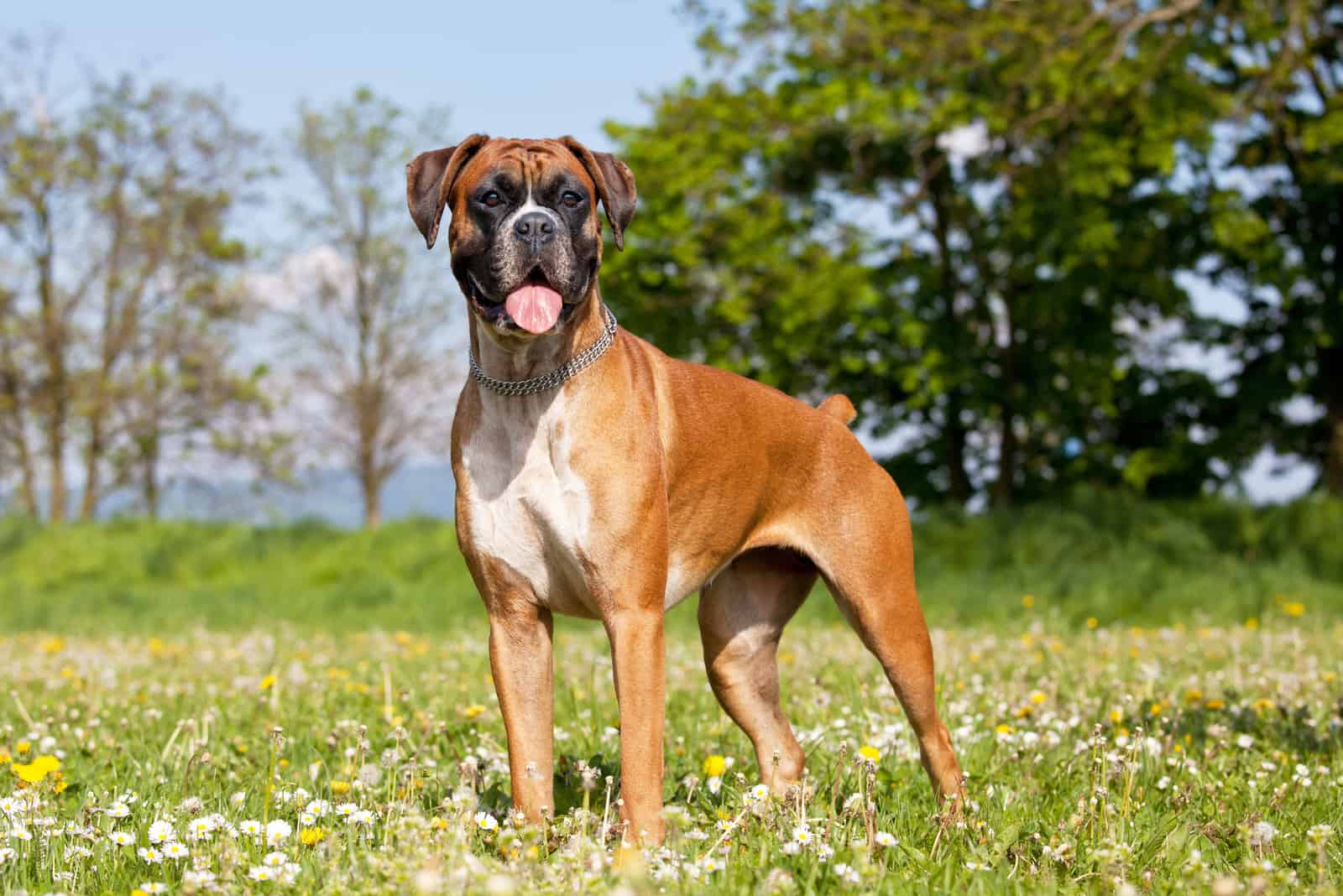Choosing the right breed of dog for your home and circumstances can be a difficult process. And once you’ve chosen a breed – the Boxer dog, in this case – you might be wondering whether to pick a male or female Boxer. However, there’s no quick and easy answer to this question!
To guide you through the process and help you decide, here’s a breakdown of male vs female Boxers.
We’ll begin with a bit about the breed’s history before launching into more detail about each sex to discover which one appeals to you the most.
The Boxer Dog Breed
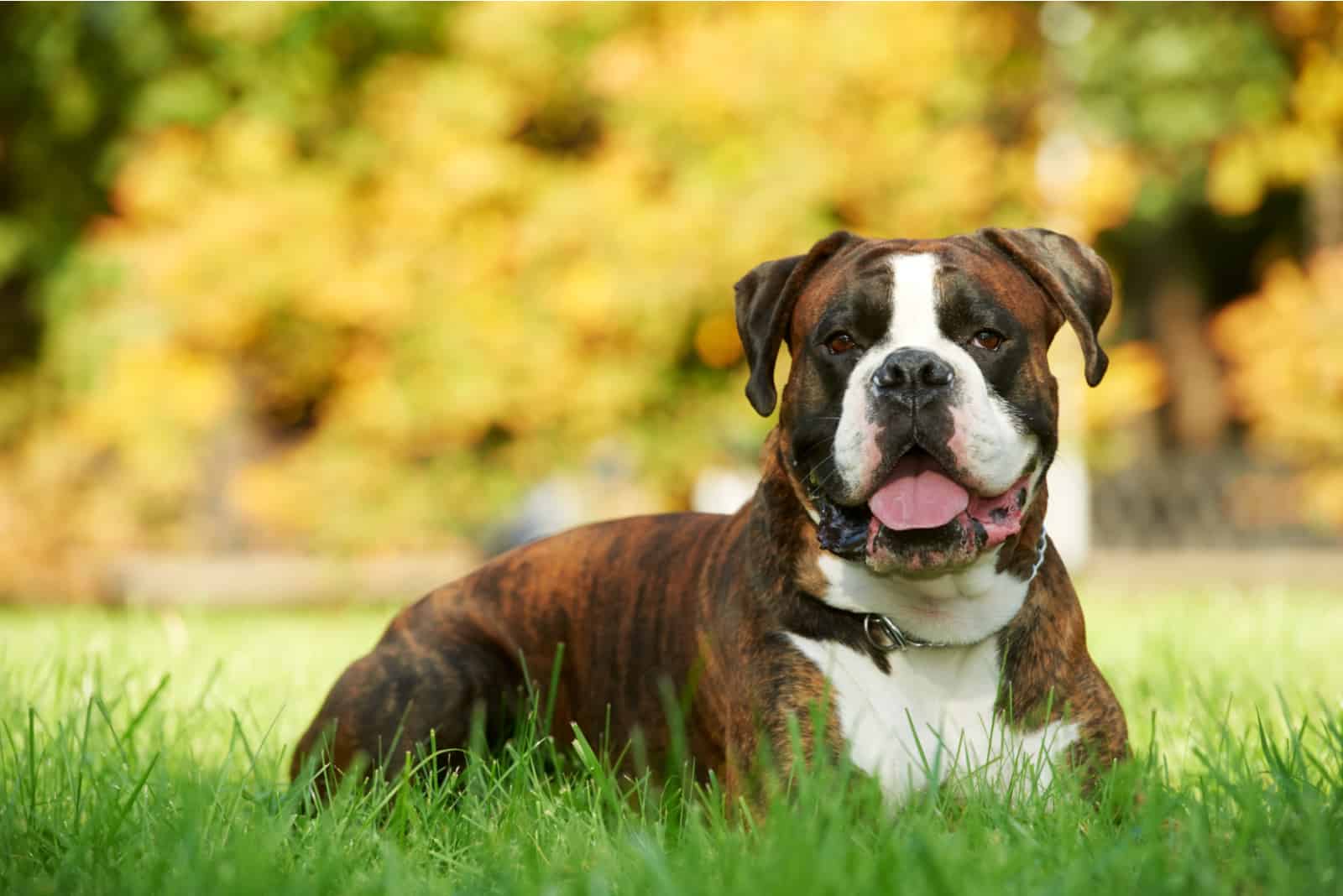
Boxers seem to be a bit of a mixture, originating in Germany during the 1800s. They are the descendants of the Bullenbaiser breeds that are now extinct and are thought to have been crossed with the Great Dane, Bulldog, Mastiff, and some type of terrier.
They usually display three different coat colors: fawn, white, and brindle, with five different types of markings: brindle, white markings, fawn markings, black mask with white markings, and black mask.
As with Bulldogs, they were bred to be used in the blood sport of bull-baiting, later becoming butchers’ dogs where they controlled cattle in slaughterhouses.
In more recent years, they have had a much happier and wholesome role, being bred as pets and companions. Because of their natural intelligence and alertness, they were among the first breeds to be used as police dogs and as helpers for people with visual impairments. Even today, they are still classed as working dogs, although they are kept as pets for the most part.
There is also some debate as to the origins of the name Boxer. Some people believe that this is connected with the breed’s tendency to stand upright and use its paws to hit out, but this is refuted by experts who say that this would result in serious injury. In any case, it’s unlikely that such an anglicized word would have been used for a German dog.
It is more likely that the word is related to the Boxer’s ancestor, the Bullenbaiser, which was called the Boxl, with Boxer simply being a corruption of the word that has stuck with us.
However the name came to be, the Boxer dog only found its way to the US after WWI, and by 1940 it had become one of the most popular breeds in America. Even today, it still stands at number 14 in the list of most popular dog breeds, according to American Kennel Club (AKC) statistics.
Overall, Boxers are prized for their friendly, playful, intelligent character. They are fun-loving, loyal, brave, and fearless while still having a sweet temperament.
Today, even many Boxer mixes exist to even perfect this amazing breed.
But what we want to know is how different the two sexes are, so let’s dive in and compare male vs female Boxers.
Are Female Boxers Good Family Dogs?
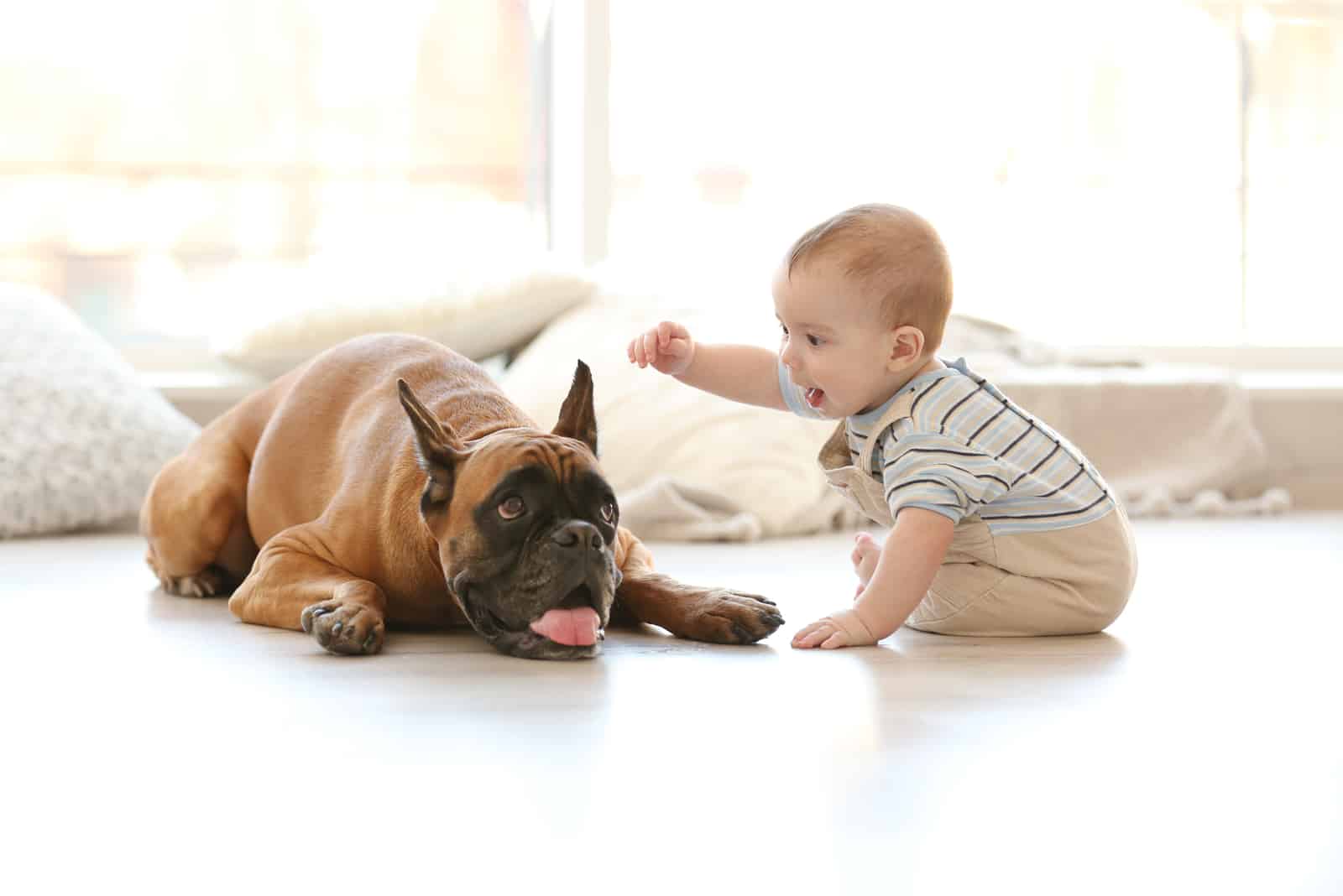
By all accounts, yes, they are! But are they any better than males?
When you choose a family pet, you need to know you are making the right choice. After all, this new addition will, for most people, be welcomed as a family member. This dog needs to fit in, to work with your family dynamic, as well as making sure that its own needs are met. It’s a huge responsibility, as with any pet.
It isn’t only about how lovely and cute they are, though the dog’s appearance will obviously influence your decision to some extent. After all, who can resist the Boxer pup’s lovely little face?
Cuteness aside, you need to weigh up all of the factors, including temperament, the size and strength of the dog, any health conditions, trainability, exercise requirements, grooming, care, and diet.
Female dogs will generally need less food as they are smaller than males. They are considered more reserved and introverted, whereas males will nearly always be outgoing and bold.
One major consideration to bear in mind is that a female Boxer will soon begin her heat cycle, which can start from between the ages of one month (though rarely) and fifteen months. Generally speaking, they will start between six months and a year.
While she is in heat, she will attract male dogs from miles around, so be warned! Each heat cycle will last for approximately ten days and will happen every six months. To save your floors and furniture from stains, you might want to invest in doggie hygiene products that are available, such as special diapers.
Boxer Temperament Male vs Female

It’s always difficult to present a 100% accurate measure of any dog’s temperament. With most breeds, you can give a general view of how they might be expected to behave, but each individual dog will have its own personality, and certain character traits will be stronger in some dogs depending on which genes they inherit from the parent dogs.
The Boxer dog is generally known for its sweet nature and for being excellent with kids. However, this should never be taken at face value.
Male Boxers are often said to be generally more aggressive than females, largely due to the fact that they can be territorial, but they are also said to be more affectionate than females. However, female Boxers will sometimes show real aggression when they are nursing a litter of pups and can also be aggressively territorial when confronted with another female dog of any breed.
Females are also the moodier of the two. They are just as loyal and will love your company, but they tend to be more reserved. Interestingly, this is more noticeable in households where both male and female dogs are present, making it easier to spot the difference. When you check dog forums online, you may see accounts from Boxer owners who only have a female at home, and they often prove to be just as affectionate as any male dog might be!
Both male and female Boxers soon form a very strong bond with the family and will assume the role of protector, especially when they watch over young children as they play. They make excellent guard dogs and will warn you of anything they believe to be a threat, even if it is just your neighbor putting out the trash! Having said this, they’re not usually excessive barkers.
Are Male Boxers Bigger Than Females?
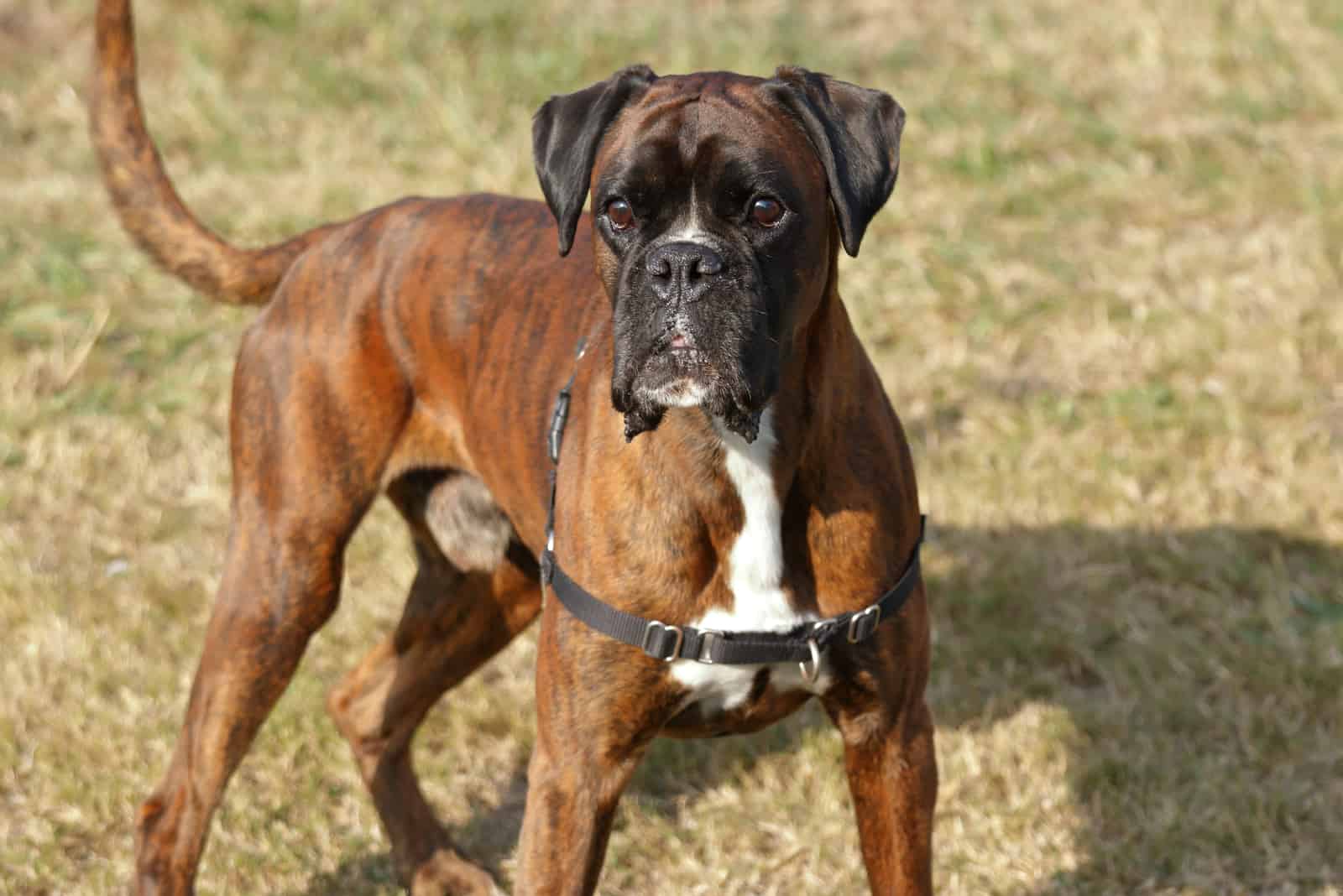
Yes, especially in terms of their weight.
Males weigh between 29.5–36 kg (65–80 lbs) and females 22.5–29.5 kg (50–65 lbs). They also differ slightly in height, with males measuring 61 cm (24 in) and females 56 cm (22 in).
Although the height difference isn’t that significant, males can be much heavier and stronger, which could be a factor when deciding which sex you should choose. These are powerful, muscular dogs that can be willful at times. Anyone who has a smaller frame may not be able to handle such a dog on a leash, so they might prefer a female boxer that will be lighter, weaker, and therefore easier to control.
Do They Have The Same Health Issues?
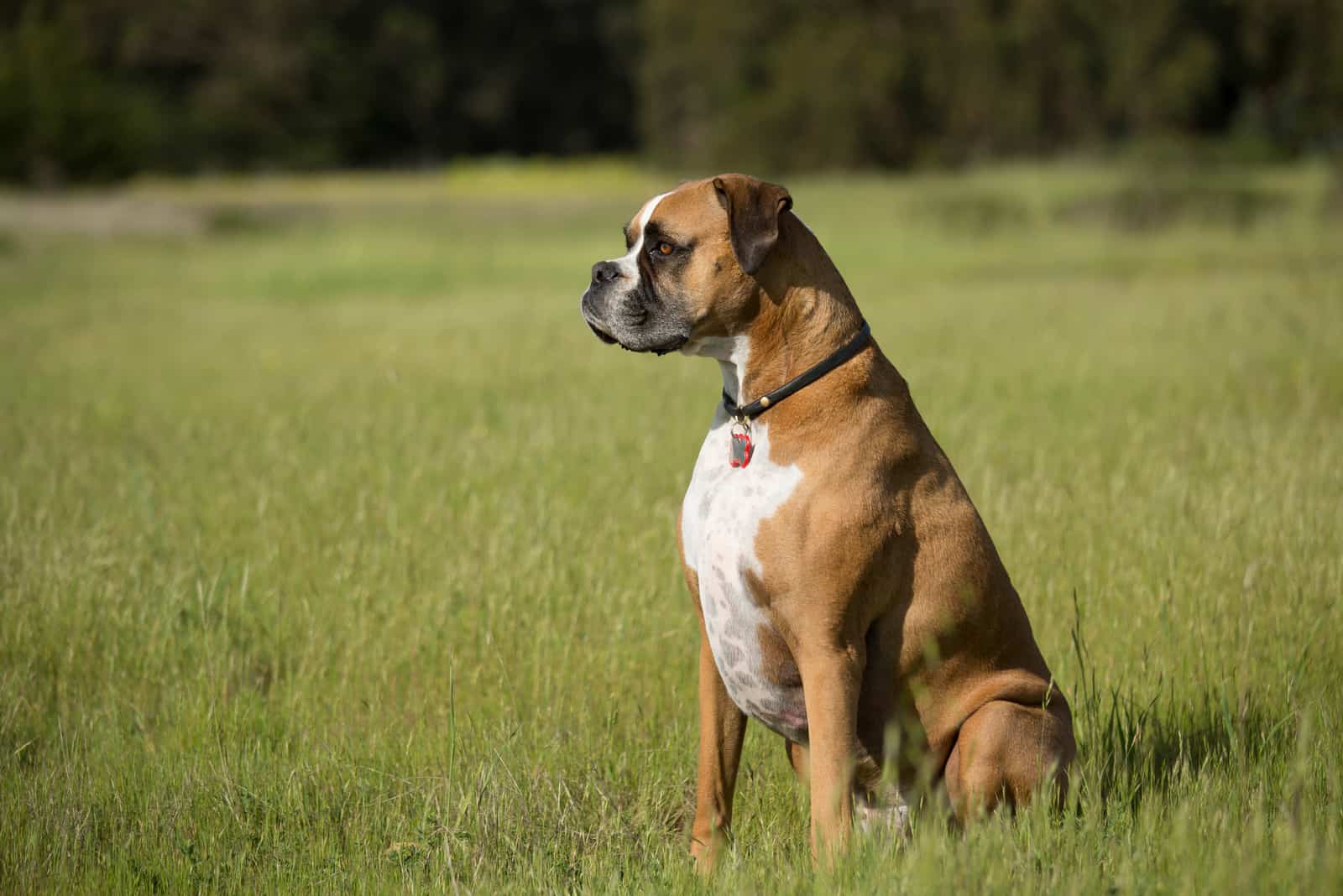
Boxers, like all purebred dogs, have their share of health problems. However, they are considered relatively healthy for a pedigree breed.
One issue that affects both sexes is that Boxers are a brachycephalic breed, which means they have a short snout and flat face. This can cause several health problems because the skull is short and flat, resulting in breathing problems, eye disorders, and an increased risk of infection in the skin folds.
Brachycephalism is a genetic trait found in many breeds, such as the Pug, English Bulldog, and Cavalier King Charles Spaniel. This condition makes the windpipe and airways deformed, as the soft tissue is more suited to a longer snout that just isn’t there. The dogs can also have narrow nostrils.
When all this is combined, it can cause serious breathing difficulties that can be life-threatening. Recent studies by the UK Kennel Club have shown that more than half of those who own brachycephalic dogs can’t recognize when their dog is struggling to breathe, so they probably wouldn’t seek veterinary assistance until it was too late.
The naturally long snout found in many other breeds also helps the dog to cool down. Brachycephalic breeds are unable to use this mechanism, so they are prone to overheating. Older or overweight dogs have been known to die as a result.
Aside from this, here are some other common health issues:
• Boxer cardiomyopathy – this disease affects the heart muscle tissue and can cause an irregular heartbeat, collapse (especially during exercise), and even sudden death from heart failure. Currently, the treatment for this condition is an anti-arrhythmic medication that reduces the effect of the disease on the heart tissue, stops the dog from fainting, and prevents death from cardiac failure.
• Cancer – Boxers are particularly vulnerable to certain types of cancer, mainly due to faulty genes being passed along through line breeding and inbreeding (the practice of breeding closely related dogs). Brain tumors, lymphomas, mast cell tumors, and skin hemangiosarcoma are among the more common problems.
• Hip dysplasia – a malformation of the hip joint that makes the bones rub together painfully, often leading to arthritis when the dog is older if not treated. It is usually resolved with total hip replacement surgery, which restores a full range of movement and allows the dog to lead a normal, happy life.
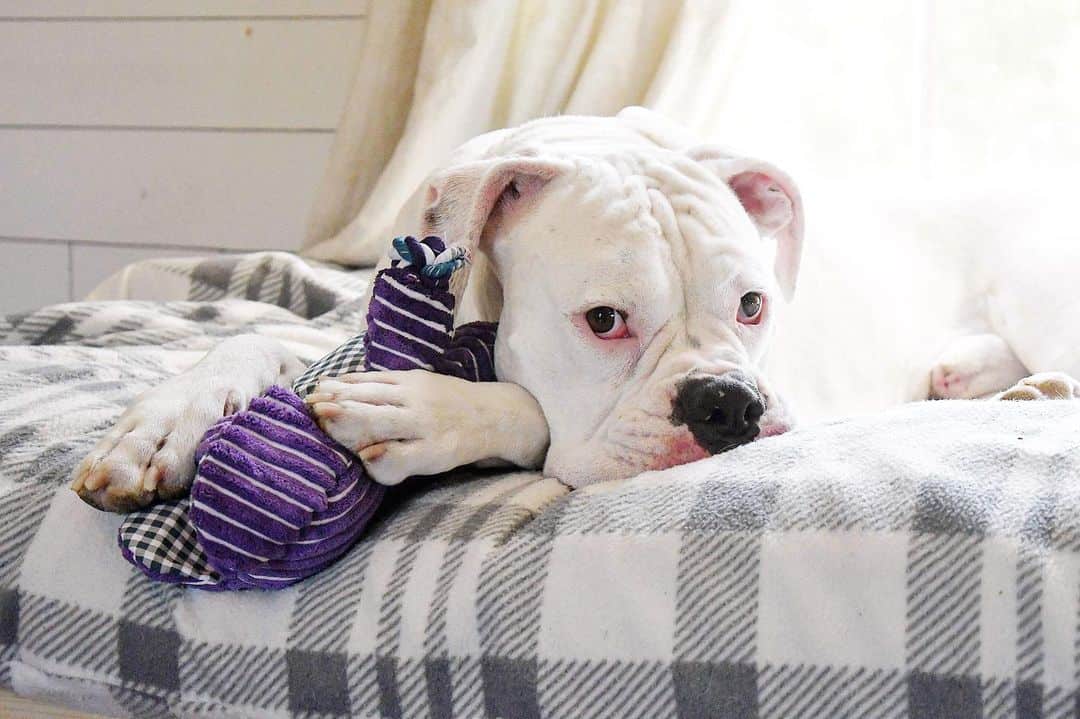
Photo from @deafwigglebutts
• Ulcerative colitis – this condition rarely affects any other breed! As the name implies, ulcers can develop in the colon, causing vomiting, diarrhea, and blood in the stool. The ulcers are caused by the swelling (colitis is inflammation of the colon) of the colon, as this destroys the lining. It isn’t just one or two ulcers either, as they tend to appear right along the full length of the colon. The symptoms are clear: uncontrollable diarrhea, blood, pus, or mucus in the bowel movement, weight loss around the ribs, burping, and vomiting. There are several causes, including acute stress, parasites, allergies, trauma, and infections such as salmonella or E. coli.
• Bloat – a potentially fatal condition (also called GDV, or gastric dilatation volvulus) when the stomach fills with gas and starts to twist, cutting off the blood supply to vital organs. The cause is unclear, but some experts have noted that it often happens after the dog has eaten too much too quickly or exercised straight after eating.
• Epilepsy – seizures can be caused by a number of conditions relating to trauma, tumors, poisoning, and degenerative brain diseases. These are known causes, but idiopathic epilepsy has no known cause and is thought to be connected to a physical fault in the brain structure.
• Hypothyroidism – an underactive thyroid gland doesn’t produce the right amount of hormones for the dog’s body to function properly, resulting in lethargy, changes to the skin and coat, and weight gain.
• Entropion – a painful condition where the excess skin forces the eyelids to fold inward, causing the hairs to rub against the cornea. Many pups will outgrow this condition by the time they reach one year of age, but it can sometimes result in ulcers and infection. Most vets are reluctant to use tacking (a type of corrective surgery on the eyelid) as it can cause complications when the dog is older if too much skin tissue is removed.
• Aortic stenosis – another heart disease that can cause an irregular heartbeat (or heart murmur) that can also result in heart failure. This is due to a narrowing of the valve that controls blood passing from the left ventricle to the aorta. The severity of the condition varies in each animal, with some dogs not displaying any symptoms and others showing obvious signs of distress. In severe cases, the dog may faint, have breathing difficulties, muscle weakness, and general lethargy. As yet, there is no cure, but symptoms can be controlled with medication.
So far, there doesn’t seem to be any evidence to distinguish whether any of these conditions affect one sex more than the other. However, when we focus on cancer, which is easily the biggest cause of premature death in Boxers, it could be said that females may be slightly more at risk because of the possibility of ovarian or mammary cancer.
Experts strongly advise dog owners to have male dogs neutered and female dogs spayed, as this significantly reduces the risk of certain types of cancer. This could also solve some of the worst behavior problems, but neutering and spaying should never be regarded as a cure-all.
On the whole, they should be healthy, especially if you treat them right and make sure they only have high-quality dog food. You can find more information on the desirable food for these dogs in our Boxer feeding chart.
Are Male Or Female Boxers Easier To Train?
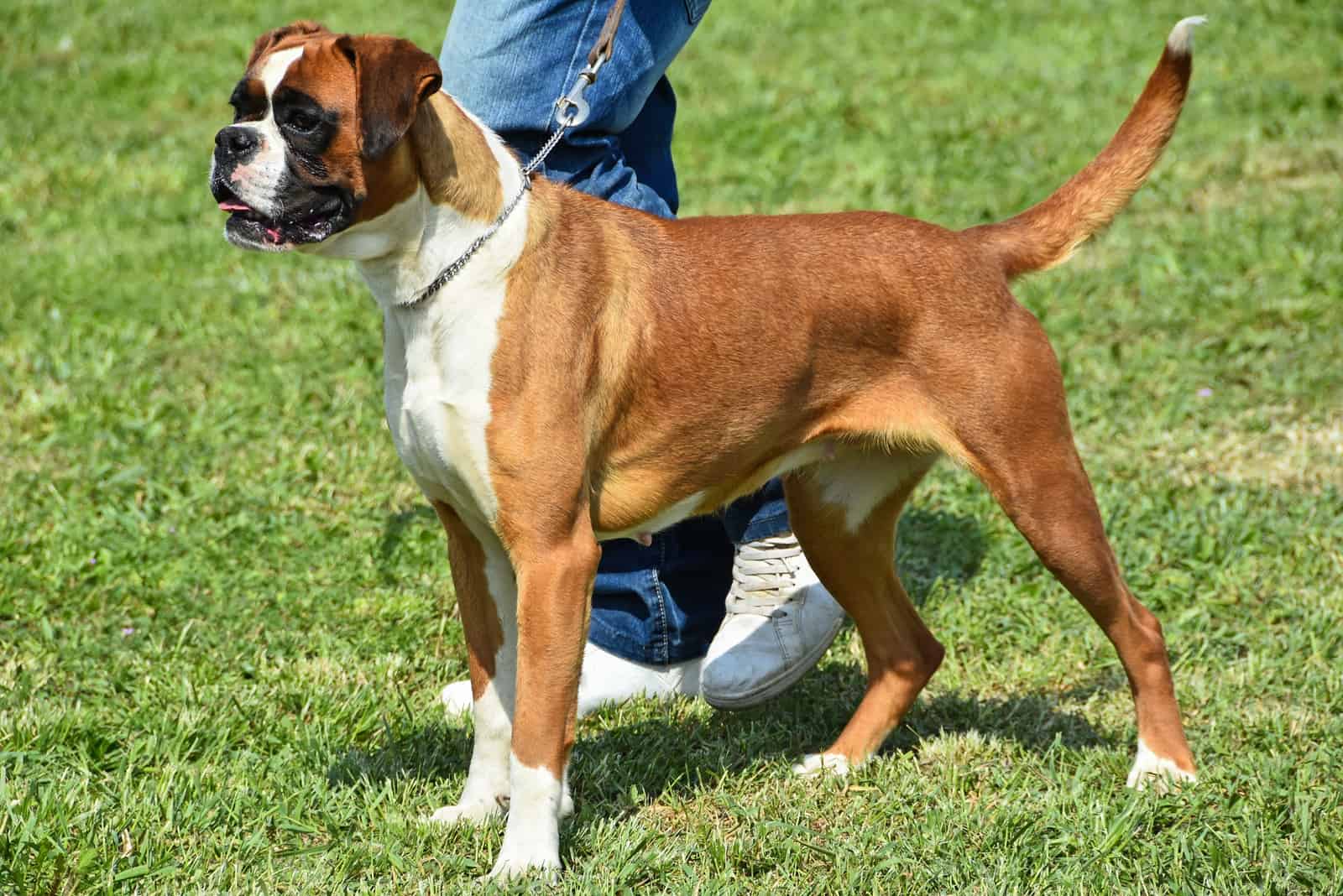
In general, female Boxers are considered easier to train, mostly as they are more submissive and won’t continually try to challenge your dominance.
Opinions are divided as to the trainability of Boxers, with some people saying that they are difficult to train and others maintaining that it is just a matter of understanding the breed.
Boxers are known for their strong will and intelligence. This can cause problems when it comes to training but can also work in your favor if you start when they are young!
The thing about Boxers is that they take longer to mature than many other breeds. The playful exuberance they display as pups as they jump about enthusiastically will stay with them until they are around three years old. At this point, they will probably settle down a bit to become calm, mature, and self-assured.
Even so, the distinctive Boxer’s Wiggle is a sign of their playful nature that you’ll see in male and female Boxer puppies alike, but this puppy-like behavior may last well into adulthood, especially in male dogs.
Therefore, we can say that female Boxers are, on the whole, easier to train, although the breed does have a reputation for presenting a challenge due to their proud, stubborn streak. Boxers don’t take kindly to loud, verbal rebukes and will sulk and become uncooperative.
Early socialization is essential to reduce their wariness of strangers and get them used to other dogs. It will make your life much easier as the dog gets older!
Potty training should begin when the pups are no older than seven weeks; any attempts before this will confuse them, and if you leave it too late, the task will be much more difficult.
Should I Get A Male Or Female Boxer?
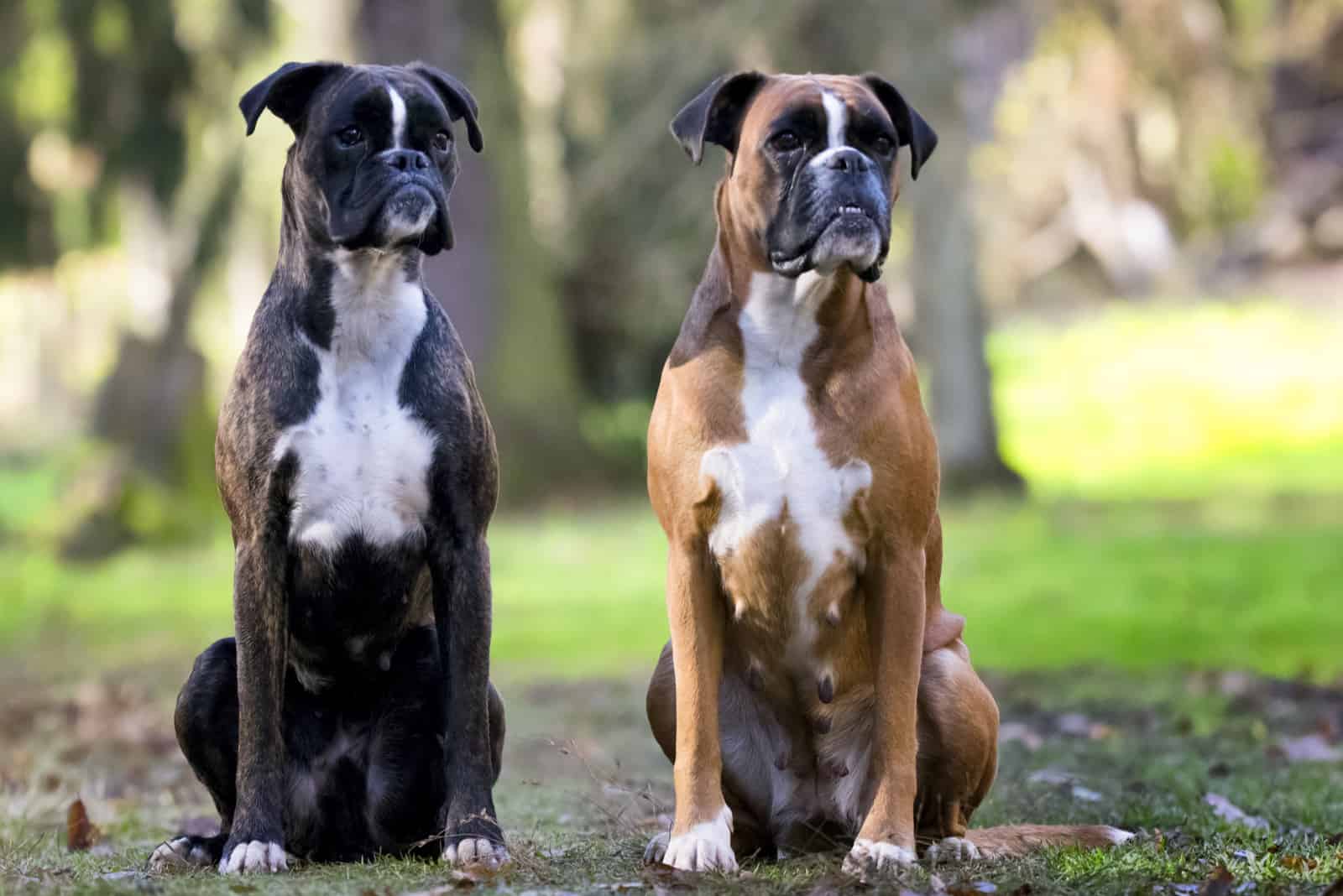
We’ve explored some of the aspects of male vs female Boxer dogs to help you reach a conclusion, so you should have a better idea of the answer by now. In the end, it won’t be anyone’s choice but yours, and it would be wrong to stress one as being better than the other.
To help you out, let’s make a list of the main points, taken from what we have learned:
[table id=16 /]
Whether you go for a male or female Boxer as your family dog, be sure to only use a reputable breeder, as this will boost your chances of picking a healthy dog. Good breeders will offer health guarantees and use ethical breeding practices to improve their chosen breed’s health in the long term. They are motivated by an interest in Boxers and keeping the bloodlines alive, rather than by pure profit alone.
Alternatively, you might want to approach an animal shelter or local Boxer rescue center. This is great, as it will provide a happy home for a pet in need, but bear in mind that older dogs may come with their own challenges, and you probably won’t have a great deal of information about the pooch’s history.
So, who’s the winner in male vs female boxers? Well, that’s up to you!
Read Next: Boxer Ear Cropping: A Necessity Or Not? Let’s Discuss

